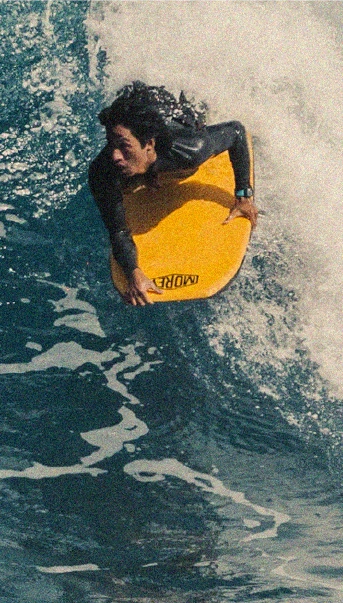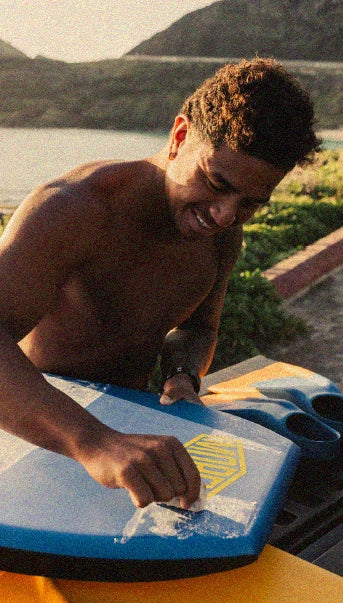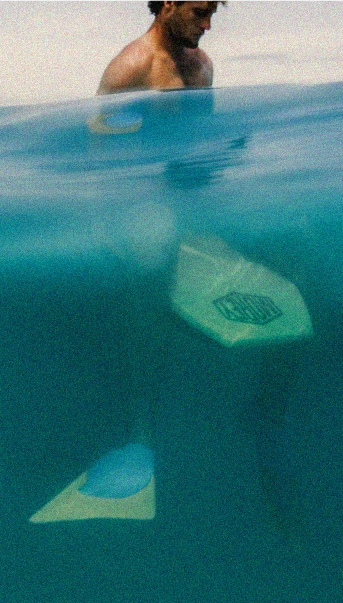Morey’s Ultimate Bodyboard Guide - Morey Bodyboards®

Welcome to the ultimate guide for choosing the perfect bodyboard! Whether you're a seasoned rider or just getting started, finding the right bodyboard is essential for an incredible bodyboarding experience.
In this guide, we'll first delve into the fundamental anatomy of a bodyboard, which will help you understand the materials of the bodyboard and how it's made, and then explore the key factors to consider when selecting a bodyboard. By understanding both the crucial elements and the intricate details, you'll be equipped with the knowledge to make an informed decision and find the bodyboard that matches your style, skill level, and wave conditions you’ll be in.
Get ready to elevate your bodyboarding game and ride the waves with confidence!
Table of contents:
Anatomy of a bodyboard:
Things to consider when choosing your board:
Anatomy of a Bodyboard
Before we dive into the nitty-gritty of choosing the perfect bodyboard, let's take a moment to familiarize ourselves with the anatomy of this incredible wave-riding tool. Understanding the various components and their functions will empower you to make an informed decision and find the bodyboard that best suits your needs and riding style.
|
|
EPS, or Expanded Polystyrene, is a lightweight and stiff foam material commonly found in entry-level or beginner bodyboards. While it may not be the most durable core material, its lightweight and buoyant nature allows for easier maneuverability, making it perfect for first-timers tackling their first waves. |
|
|
PE, or (Polyethylene), has been a staple material in bodyboard manufacturing since the mid-1970s. Known for its exceptional durability and excellent recoil, it offers impressive control and responsiveness. The performance with this core type is excellent in most water temperatures, except for very warm conditions (75F/23C) where it tends to become softer. It is the heaviest among the three common core types, providing added stability and a solid feel in the water. |
|
|
PP, (Polypropylene), is the ultimate core material for bodyboarding. PP cores offer a lightweight and high-performance experience. With 100% waterproof properties, it remains lightweight throughout the board's lifespan. Polypropylene is known for its durability and ability to maintain flex characteristics in all water temperatures, making it a top choice for riders seeking optimal performance. |
|
The XPE deck is made of cross-linked polyethylene foam, offering a lightweight, soft, and durable option that absorbs impacts and provides excellent rider comfort. Its low moisture permeability makes it highly effective in keeping water out. |
|
|
The IXL deck offers superior water-resistance and durability with its fine cell structure and minimal water absorption. It provides excellent grip for wave-catching and tricks. Resistant to sea water damage, it's a reliable and sturdy option. Note that because of its hardness, it may cause skin irritation and has less shock absorption compared to other decks. |
|
|
The TC6.5 deck features 6.5lb PE decking foam, representing its density per inch. This soft and flexible PE decking allows riders to mold their boards over time, creating a personalized foam memory for maximum comfort. Despite its softness, PE decking remains remarkably durable and resistant to creasing, regardless of water temperature or wave conditions. |
|
|
The TC8 deck features 8lb PE decking foam, which refers to the density per inch. Slightly denser than the TC6.5 but still remains soft and flexible. Riders can wear into their boards over time and create a foam memory where they feel most comfortable. Despite being soft and flexible, PE is still incredibly durable and resistant to creasing in any water temperature or wave conditions. |
|
The bottom of the board is covered with high-density polyethylene, known as HDPE. This specialized material provides a smooth, glossy, and friction-resistant surface, allowing for effortless gliding and maximizing speed on the water. |
|
|
The belly of the board is covered in Surlyn, the same durable material used in golf ball coatings. It's resilient and minimizes creasing. It's stiff, yet flexible enough to enable the board to effortlessly respond to wave curves under pressure! An upgrade from an HDPE slick! |
Contours are the curves and shapes on the bottom of the board that help you glide effortlessly through the waves. Contours come in various forms, such as channels and concaves. These contours create a magical interaction between the board and the water, enhancing speed, control, and maneuverability.
The nose of a bodyboard is like the prow of a ship, leading the way through the waves. It's the front part of the board that allows you to initiate turns, cut through the water, and ride with precision. Nose designs can vary, from wide noses to small and sometimes even rounded ones.
The bodyboard's tail is like its personality, adding both style and function to your ride. Two popular tail shapes are the crescent and bat tails. The crescent tail offers a smooth and responsive ride, allowing quick reactions to sudden movements for enhanced maneuverability. It remains the most widely used tail type worldwide. On the other hand, the bat tail, invented by legendary bodyboarder Mike Stewart, resembles bat wings and provides extra lift and release. Perfect for riders who enjoy launching off the lip and performing aerial tricks, it adds an exciting dimension to your wave-riding experience.
The wide point of a bodyboard is the widest part of the board, and its position is crucial for determining how your body weight should be distributed on the board. A forward wide point offers stability for prone style riding, while a centered or rearward wide point provides maneuverability dropknee style riding.
|
A single rod stringer embedded in the core. This stringer provides added strength and rigidity to the board, enhancing its overall performance and durability. Experience increased responsiveness and control with the single rod stringer icon. |
|
|
Two stringers embedded in the core. These dual stringers provide maximum strength and stiffness, resulting in enhanced board performance and responsiveness. The double stringer design allows riders to confidently tackle powerful waves and execute precise maneuvers. |
|
The X-FLEX mesh prevents over-flexing and distributes impacts evenly throughout the board. It is a plastic chicken mesh wire embedded across the core, sandwiched between the deck and the slick. Ensures optimal resilience and responsiveness. |
The rails of a bodyboard refer to the edges that run along the sides of the board. They bring some serious maneuverability to the table. You've got options when it comes to rails – they can be sharp or rounded, each offering its own unique ride.
|
A bodyboard leash is included with your board. No need to purchase it separately! The leash plug is also pre-installed, saving you time and effort. Get ready to hit the waves with everything you need for a safe and enjoyable ride. (Please note that our pro series boards may not come with a leash as many professional riders have specific preferences for leash type and placement of the leash plug. This allows them to customize their equipment according to their individual needs and riding style) |
By familiarizing yourself with the anatomy of a bodyboard, you gain valuable insights into how each component contributes to your riding experience. Every part of a bodyboard plays a crucial role in the board's performance and functionality.
How to Choose Your Bodyboard
Now that we've covered the essential anatomy of a bodyboard, it's time to explore the key factors to consider when selecting your ideal board. As you embark on your bodyboarding journey, these considerations will help you find the perfect match that aligns with your skill level and riding preferences.
- Skill Level: When it comes to choosing the right bodyboard, your skill level should dictate the type of board you select. Whether you're a beginner, intermediate, or advanced rider, selecting a bodyboard that matches your skill level can greatly enhance your performance in the water.
- Beginner Riders: We recommend opting for a board with more stability and buoyancy. Look for boards with a larger template and reasonable flex, as these features provide better control and forgiveness while you're still learning the ropes. A wider nose and tail can also help with stability and make it easier to catch waves.
- Intermediate riders: Those who have gained some experience and confidence may want to explore boards with increased maneuverability. Consider a board with a slightly narrower template and a medium flex, allowing for more responsive turns and greater control in varying wave conditions. Additionally, experimenting with different tail shapes, such as crescent or bat tails, can provide different riding experiences to match your preferences and style.
- Advanced riders: Those who are seeking high-performance boards for more challenging waves and maneuvers have a wide range of options to choose from. These riders can benefit from boards with a narrower template, increased speed, and stiffer flex. Look for boards that offer greater responsiveness and quick rail-to-rail transitions, enabling you to push the limits of your skills and take on more demanding waves.
Remember, selecting a bodyboard that aligns with your skill level not only enhances your performance but also ensures your safety in the water. It's essential to progress gradually and choose a board that challenges you without overwhelming your abilities. As you continue to improve, you can always upgrade to a more advanced board that matches your growing skill set.
At Morey, we've made it easier for you. Check out our visual guides to find the perfect board suited for your skill level.
|
Beginner boards are the most affordable option. They are stable and reliable for learning the ropes. While not the most durable option, they are a great choice for those who are just starting out. |
|
|
Versatile boards designed for progressing riders. With a balanced combination of performance and durability, these boards have design features that offer enhanced maneuverability and speed. These boards are for intermediate riders looking to take their skills to the next level. |
|
|
With a focus on durability and responsive performance, these high-performance boards excel in delivering optimal results. These boards exhibit excellent flex characteristics across different water temperatures, ensuring consistent performance in various conditions. While they may be on the more expensive side, their premium quality and ability to handle the demands of professional riding make them a worthwhile investment. |
- Board length and width: The size of your bodyboard should be proportional to your height and weight. A board that is too short or too narrow may make it difficult to catch waves, while a board that is too long or wide may be harder to maneuver. Here are some general guidelines to help you choose a bodyboard with the right length and width for you.
- Length: Generally, the length of your bodyboard should be between your navel and your knees when you stand it up vertically. This ensures that the board is the right size for your height and weight, and will provide optimal buoyancy and maneuverability in the water. Shorter boards are more maneuverable and better for tricks, while longer boards offer more stability, speed, and are better for bigger waves.
- Width: The width of your bodyboard should be based on your weight and skill level. If you are a beginner or on the heavier side, you will want a wider board for added stability. If you are more experienced and lighter, a narrower board will give you more maneuverability and control in the water.
For a more comprehensive and accurate guide on how to choose the right bodyboard, we recommend checking out our size guide. Our size guide includes a height-weight-board size chart that will help you find the perfect fit based on your body size and personal preferences.
- Riding Style / Shape: Another important factor to consider when choosing a bodyboard is your riding style. There are different types of riding styles, such as drop knee, prone, and stand-up, and each style requires a different type of board. Here's a breakdown of the most common riding styles.
-
Prone: Riding prone style on a bodyboard means riding on your stomach with your fins facing down and your head facing forward. This is the most common and beginner-friendly riding style for bodyboarding.
Prone Style Bodyboard Shape: To accommodate prone riding, the ideal bodyboard should support the upper body of riders who mainly lay down while riding, with its widest point typically located further forward on the board.
-
Dropknee: Dropknee riding is when a bodyboarder places their preferred fin forward on the front of the deck with the opposing knee on the bottom end of the board with their fin dragging in the water.
Dropknee Style Bodyboard Shape: The ideal dropknee style bodyboard should feature a lower wide point halfway down the board and a narrow tapered nose so that most of the weight can be on the back of the board.
(If you're a fan of drop knee riding, then the Morey Mach 7-SS is the perfect board for you. With knee contours specifically designed for this riding style, the Mach 7-SS provides additional stability and control when performing drop knee maneuvers.)
-
Combo: A combo board is a board that has a versatile shape to accommodate both prone and dropknee styles of riding.
Combo Bodyboard Shape: A combo board is designed with the widest point near the middle of the board, allowing it to accommodate both prone and drop knee riding styles. The rocker (curve) of the board may also be slightly less pronounced to allow for smoother transitions between riding styles.
It's important to take your riding style into account when choosing a bodyboard, as it can greatly affect your performance and overall experience in the water.
Keep an eye out for these informative visual guides that will help you find a Morey board tailored to your specific riding style!
|
Tailored specifically for prone style enthusiasts, prone style boards are usually designed with a higher wide point and a larger nose. This unique design provides increased surface area near the nose, allowing for improved stability and control when riding in the prone position. |
|
|
Designed specifically for drop knee specialists, DK or dropknee boards feature a compact nose and a lower wide point compared to prone-specific shapes. This strategic design allows for weight distribution towards the middle or back of the board, optimizing control and stability while riding in the kneeling position. |
|
 |
Combo style boards combine the best features of prone and drop knee boards. Enjoy the versatility of a board that caters to both riding styles, offering enhanced stability, control, and maneuverability. Switch effortlessly between prone and drop knee riding with this versatile board. |
Another important consideration when choosing the right bodyboard is taking into account the water temperature you'll be riding in. Different water temperatures can have an impact on the performance and flex characteristics of your board. Here are some key points to keep in mind:
-
Warm Water (75°F/24°C and above): In warm waters, Polyethylene (PE) boards may become too soft, compromising control and responsiveness. Instead, consider boards with EPS or Polypropylene (PP) cores. PP boards are lightweight, durable, and offer a faster ride with better speed out of turns.
-
Temperate Water (70-75°F/21-24°C): In temperate waters, most bodyboard cores perform well. However, if you want the best performance, PP cores are the preferred choice. They are lighter, stronger, and have excellent shape recovery, and generally have the longest lifespan out of all core types.
- Cold Water (Below 70°F/20°C): While PP boards may seem tempting in cold waters, their extra stiffness can lead to discomfort and a lack of control. PE cores, on the other hand, are more forgiving and offer increased flex, making them more suitable for bigger waves and shore breaks.
It's worth noting that PP boards generally last longer than PE boards. However, in certain conditions and wave types, some riders may prefer the increased flex of PE cores for better wave-face adaptation.
-
Leash Compatibility: Make sure the bodyboard you choose is compatible with the leash you plan to use. Some bodyboards come with built-in leash plugs, while others require a separate leash attachment. Most bodyboards have a leash plug designed for a thin leash string, while others may require a thicker leash string. Make sure to choose a board with a leash plug that is compatible with the type of leash string you plan on using.
- Leash Placement: Another crucial aspect to consider is the positioning of the leash plug, which can impact your riding style. For prone riding, having the leash plug located closer to the front of the board allows you to attach it nearer to your wrist or bicep, providing better control and maneuverability. On the other hand, for drop-knee riding, placing the leash plug closer to the end of the board is more suitable, enabling you to attach the leash nearer to your ankle, enhancing stability and balance. It's worth noting that some boards come with built-in leash plugs, so if you prefer to install it elsewhere, ensure you select a board without a pre-installed plug for customization purposes.
Our Progressive Series bodyboards come with built-in leash plugs, while our Pro Series bodyboards require you to install your own leash and plug. Also check out our own Morey Wrist Leash and Bicep Leash.
For a comprehensive guide on how to properly install a leash and plug on your bodyboard, we invite you to check out our blog post: Installing a Bodyboard Leash and Plug: Morey's Step-by-Step Guide. It offers detailed instructions and valuable tips to ensure a secure and safe installation. Happy riding!
|
Bodyboard Size
|
Morey Board
|
Height
|
Weight
|
|
38” |
M38 |
4' 8" - 5' 2" |
65 - 120 lbs. |
|
40” |
MACH 10 |
5' 3" - 5' 6" |
110 - 140 lbs |
|
41” |
MACH 7, MACH 10 |
5' 6" - 5' 8" |
125 - 170 lbs. |
|
41.5” |
MACH 7X, MACH 7-SS |
5' 6.5" - 5' 8.5" |
135 - 175 lbs |
|
42” |
MACH 7, MACH 10 |
5' 7" - 6' 0" |
145 - 180 lbs |
|
42.5” |
MACH 7X, Cruiser, MACH12 MDS, MACH 12 ECO-TECH |
5' 9" - 6' 1" |
160 - 195 lbs |
|
43” |
MACH 7, MACH 7-SS |
6' 1" - 6' 3" |
170 - 210 lbs. |
|
44” |
Big Kahuna |
6' 2" - 6' 4" |
180 - 250 lbs |
We understand that selecting the right bodyboard size can be a bit tricky, so we've provided this size guide to help you make the best decision. However, if you can't find dimensions that exactly match your height and weight, don't worry, here are some tips!
When in doubt, consider your weight first. This is because your bodyboard needs to provide the right amount of buoyancy to support you in the water. A heavier rider might sink too much into the water on a board that's too small, leading to drag and slowing you down. On the flip side, a board that's too large might float excessively, making it difficult to control and navigate through waves.
So, if you're torn between sizes, choose a board that best aligns with your weight. This will ensure that the board has enough volume to keep you afloat while you're catching waves. Remember, while our guide is based on general recommendations, the perfect board also depends on personal comfort and riding style.
Still unsure about your perfect fit? We're here to help! Feel free to reach out to us via email info@moreybodyboards.com or via our contact form. Our team of bodyboard enthusiasts is ready to provide personalized recommendations based on your specific needs.



